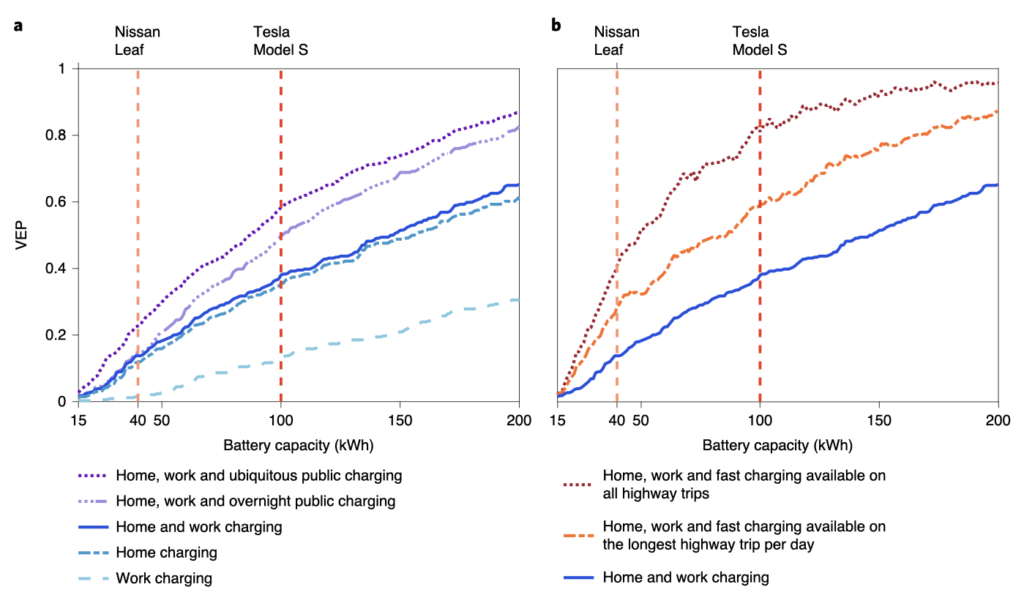Researchers from MIT this month reported that public direct current (DC) fast charging (120 kW) and ubiquitous public Level 2 charging (6.6 kW) greatly increase the number of days per year that fully electric vehicles (Battery Electric Vehicles or BEVs) will satisfy all driving needs. Given the high costs and challenges involved in constructing public charging infrastructure, rigorous analysis such as this can guide policymakers in deciding where and how to facilitate new infrastructure. The conclusion is that building such infrastructure is critical to increasing the number of electric cars on the road, which in turn is a key step toward reducing greenhouse gas emissions from transportation.

The graphs above illustrate the percentage of BEVs in Seattle whose energy requirements can be covered on all days with various types of charging available. Figure 1a on the left shows that only 14% of 40 kWh BEVs and 38% of 100 kWh BEVs can be fully served with home and workplace charging, and that adding ubiquitous public charging substantially increases the number of vehicles whose needs are met. More and more retailers and parking facilities are installing Level 2 charging, and this report justifies the value of those chargers to drivers who do much of their driving around town and can charge during their various errands.
A separate concern to EV drivers is long distances. Perhaps not surprisingly, the report shows that highway DC fast charging (at 120 kW) dramatically increases the number of BEVs whose energy needs can be met every single day of the year. Figure 1b shows that fast charging on all highway trips essentially doubles the number of vehicles whose fueling needs could be met fully. For families that have access to a combustion vehicle in addition to their BEV, using the combustion vehicle just a few days per year completely alleviates the concern.
A corollary to the findings illustrated above is that most drivers rarely need public fast charging, and that when they do the charging sessions tend to be short. The following graphs illustrate the number of days per year that a 40 kWh BEV uses a fast charger and the session lengths.

On the one hand this makes building out the necessary infrastructure easier because less capacity is required. On the other hand, low utilization impairs the economic viability of the chargers. Further complicating the story is that demand tends to increase at peak times such as around holidays; specifically, 32% of the unelectrified vehicle-days occur on federal holidays or on the five days before and after each holiday.
Not addressed in the study is the benefit that ubiquitous Level 2 charging offers to plug-in hybrid electric vehicles. This scenario is important because energy storage capacity of fully electric vehicles is rapidly increasing, meaning that the 40 kWh vehicles discussed in the study will become fewer and fewer. Meanwhile the 100+ kWh vehicles rarely require public Level 2 charging. And that is where plug-in hybrids come in. Although vehicle manufacturers are aggressively increasing their fully-electric offerings, there will be a transition and during that time many plug-in hybrids with modest electric ranges will greatly benefit from widespread Level 2 convenience charging. And even once the wave of fully electric vehicles peaks, convenience Level 2 charging will remain beneficial for use-cases such as extreme cold weather, high-mileage around-town days, and for drivers who do not necessarily have reliable access to a charger at home.
For more information about EVs and EV charging, I invite you to follow me on LinkedIn and visit my other posts.

